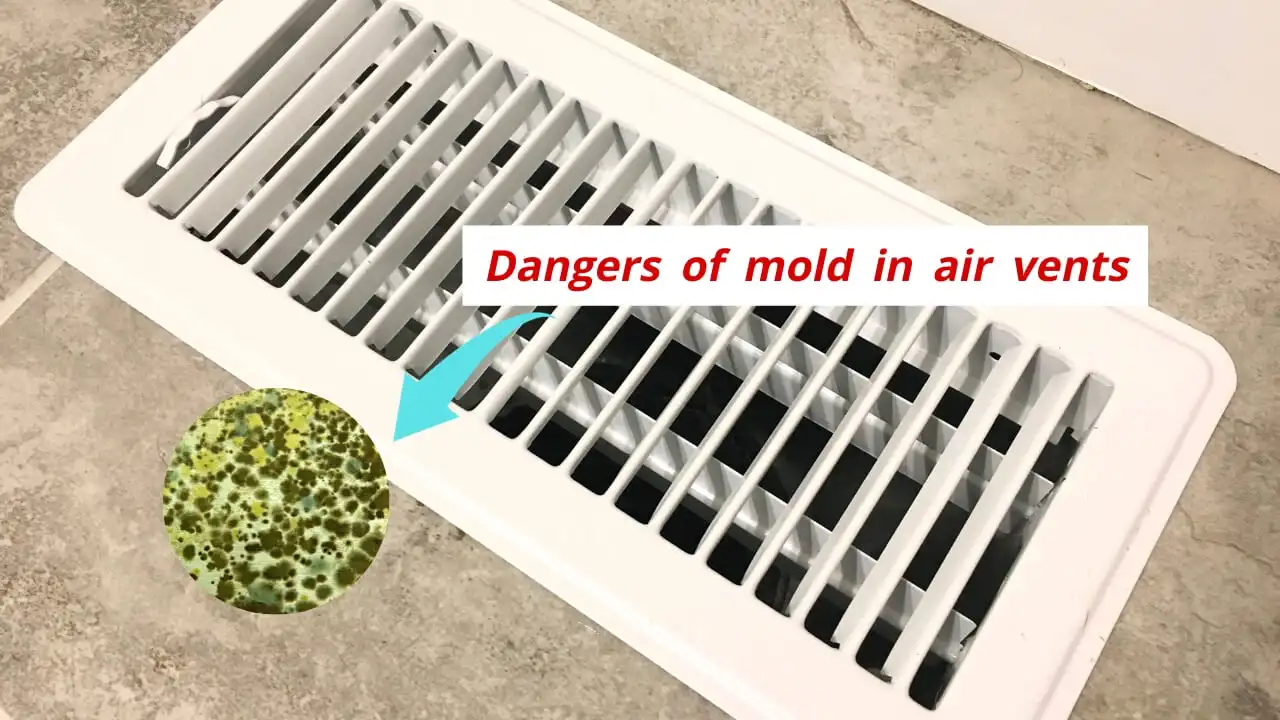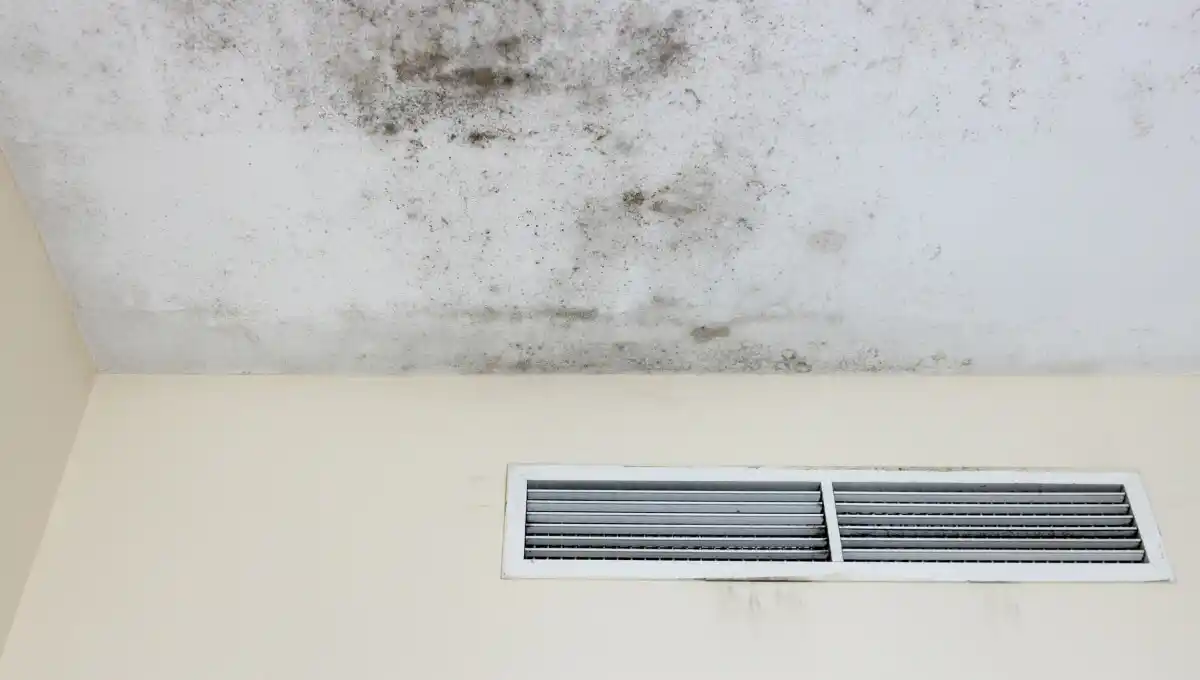Have you ever thought about the air vents in your home? Well, there’s something you might not see hiding inside them—mold. You might ask, “Is Mold on Air Vents Dangerous?” The simple answer is yes. Mold is a common household fungus that can grow in different places, including air vents. While not all mold is dangerous, some kinds can release spores that might cause breathing and health problems. For instance, black mold is truly dangerous.
In this blog, we’ll talk about what mold is, the risks it brings, and, most importantly, what you can do to deal with it.
Let’s explore the world of air vents, mold, and how it can affect your home and health.
What is Mold?
Mold is like a tiny living thing that grows in places that are wet and not very bright. One of its favorite spots is the pipes where the air travels in your home, called air ducts. If you ever smell something kind of old and musty, or if you see mold on the part where the air comes out, it’s important to take care of it right away.
Mold likes to grow in these places, and we want to stop it from spreading. So, if you notice any strange smells or see mold in your air vents, it’s really important to deal with the problem quickly.
Is Mold on Air Vents Dangerous?
Not every mold is bad. Some molds are okay, but others, like black mold, can make stuff called spores that might make you sick. If you’re worried about mold in your air vents, it’s best to get a professional to test it.
Black Mold
Black mold is a kind of fungus that can be harmful. This mold is dark black or sometimes greenish-black or gray, and it feels slimy and wet compared to other molds.
Now, where does black mold come from? It likes to grow in damp places. You might find it on things like wood, walls, carpets, and, you guessed it, air vents. If you don’t take care of your air vents, there can be too much dust and moisture, and that’s like an invitation for black mold to come in and stay.
So, is black mold in the AC unit dangerous? Yes, when black mold in the AC vent grows, it releases tiny particles called spores into the air. These spores have something called mycotoxins, which are kind of like toxic chemicals. If there’s mold in air ducts, health problems persist like —
- feeling tired,
- getting nauseous,
- having headaches,
- and even causing long-term issues with your lungs.
So, it’s important to keep an eye on your air vents and make sure they stay clean and dry to avoid black mold troubles.
Read our blog to find out the common types of mold in air ducts.
Symptoms of Mold in Air Vents
As per mold in air ducts symptoms, the CDC states there are no fixed rules about how much mold is okay to have in a home. It’s essential to know that every home has a bit of mold.
But if you think you might have mold in your air ducts or vents and you’re not sure, there are some things to watch out for. Keep in mind that these signs don’t always mean there’s mold and could be caused by other things. Here are some possible signs that there might be mold growing in a home’s heating and cooling system:
Strange Smell
One way you might discover black mold is if you notice an odd smell coming from your vents when your AC is on. Black mold has a musty, earthy smell, kind of like how rotting leaves smell. You’ll probably notice this smell more when your AC is running, and the cool air is moving through the vents.
Even if you try to get rid of the weird smell in your home, it will keep coming back until you get rid of the mold.
Black Dust Near Vents
Seeing black spots or dust around your air vents is a clear sign of black mold. If you notice these black spots, don’t touch them with your bare hands because they can irritate your skin and cause rashes. Instead, you can use a mixture of 1 part bleach and 3 parts water to wipe away the visible mold spots.
But keep in mind, this is not a complete solution to the mold issue since the main problem is probably inside the air ducts. If you don’t fix the whole problem, the black mold spots will likely come back.
Frequent Headaches
Headaches are a common thing that can happen if there’s mold on air vents in the apartment. However, it’s easy not to notice this early signal. These headaches might not feel too bad in the beginning, but as time goes on, they can happen more often and become more serious. You might even see that your headaches go away when you’re not at home.
Fatigue
If you feel really tired for no clear reason, it could be because of a mold issue. This is a common health sign that some people might go through. If you realize you’re unusually tired, talk to your doctor. And if there’s a mold problem, get in touch with an HVAC professional.
Persistent Respiratory Issues
If you find it tough to breathe or keep coughing a lot for a long time, that’s called persistent respiratory issues. It’s like your body’s way of telling you something might be wrong with the air you’re breathing.
Allergy-Like Symptoms
Sometimes, mold in air ducts can make you feel like you have allergies. You might sneeze a lot, have a runny or stuffy nose, or your eyes might get itchy. These are symptoms similar to allergies.
Unexplained Illnesses
If you’re getting sick, and you’re not sure why, it’s called unexplained illnesses. Mold in air ducts could be one of the reasons you’re not feeling well.
What Causes Mold in Air Vents?
So, what causes mold in AC vents? Mold really likes wet places, so it’s not a surprise that air vents, where moisture can get trapped from things like water droplets or leaks, can become a good home for mold. Other things that can help mold grow in air vents are:
Not Enough Fresh Air
If the air vents don’t get enough fresh air, moisture can build up, creating the perfect conditions for mold.
Dust and Dirt
Mold can use dust and dirt as food, so it’s important to make sure your air vents are clean.
Leaks
If there are leaks from pipes or the roof, that can bring moisture into your air ducts, making it a cozy spot for mold to grow.
Oversized AC
If your air conditioner is too big for your home, it might cool things down really fast (even though your electricity bill might not like it). But, it won’t take away the dampness from your home like it’s supposed to. And guess what? A damp place is just what mold loves.
Low Temperature
If you set your air conditioner to super, super cold temperatures, it might feel good, but the extra cold air mixing with the warm room air can make moisture. If this moisture doesn’t go away, it’s like a welcome mat for mold to start growing around the vents.
Humidity
Mold really likes humidity, and in the summer, there’s a lot of it. When humidity levels go above 55%, it provides a good environment for mold to grow. If using your AC doesn’t do the trick to keep the humidity low in your home, think about getting a dehumidifier. It can help stop mold from growing.
Read our blog to find out the best time of year to clean air ducts.
How to Get Rid of Mold in Vents?
So, how to get rid of mold in air ducts or vents? You can’t always be sure if there’s mold in your air vents or ducts unless you test for it, especially if you can’t see it. Once you’ve tested and found mold, it’s time for the cleanup.
Several ways can help in mold remediation for air ducts or vents, but for safety and proper removal, it’s best to get a professional’s help.
Follow these steps to make sure your home stays mold-free and healthy for you and your family.
Find Where the Mold Comes From
It can be hard to figure out where the mold is coming from, but it often happens in homes with water leaks. If you’re dealing with mold, locate and fix any water leaks, like a leaky air duct.
Turn Off Your HVAC System
This will help prevent mold spores from spreading throughout your home.
Get a Professional to Test
While there are DIY mold test kits, it’s safer to let a professional handle testing if you suspect mold.
Do Mold Cleanup
If the mold test shows there’s mold in your air vents, you might need mold cleanup. A specialist in mold cleanup will know the right way to do it, including using protective gear and proper tools. They’ll remove the mold without putting you or your family at risk. After cleanup, the professional should retest to make sure it worked.
If professional help is not available for the time being, you can use a vacuum cleaner with a HEPA filter to suck up the dust and dirt from your air vents. You can also use a solution that kills mold to clean the vents.
The CDC recommends asking the professionals you hire about the guidelines they follow for mold remediation for duct cleaning. Look for them to mention guidelines from the American Conference of Governmental Industrial Hygienists (ACGIH) or other guidelines from trustworthy organizations.
How Can I Stop Mold in My Air Vents?
The best way to avoid getting sick from mold and the trouble of getting rid of it is to stop it from growing in the first place. Here’s what you can do to prevent mold:
- Replace the air conditioning filter every month.
- Stop condensation by insulating the ducts.
- Get a dehumidifier. Use it in places that feel damp or smell musty to stop mold from growing.
- Clean drip pans often. Keep the pans under your AC unit clean to avoid mold.
- Look for any water leaks and seal them up so mold can’t grow.
- Think about UV lights for your HVAC system.
Hire a professional air duct cleaner if you think there’s mold in your vents. At Austin Chimney & Air Duct Solutions, we offer expert cleaning to reduce mold spores. Cleaning usually doesn’t mean replacing ducts unless they’re damaged. Keep your home healthy with our air duct cleaning services in Austin, Texas. Get your free estimate now!
Wrapping Up
To sum it up, it’s really important to know about the possible dangers of mold on air vents. “Is Mold on Air Vents Dangerous?” The easy answer is yes. Mold, especially black mold, can make you sick, causing problems like trouble breathing or a musty smell. If you think there’s mold, do things to stop it and get experts to clean properly. This way, you can make sure your home is a healthier place for you and your family.
FAQs
Can mold in air vents make you sick?
Sure, mold in air vents can make you sick because it releases bad stuff called spores that can lead to problems with breathing and other health issues.
What causes mold in the ductwork?
Mold in ductwork happens when there’s too much moisture and not enough fresh air, making a wet space where mold can start growing.
Does duct cleaning remove mold?
Sure, cleaning the ducts can get rid of mold, making the air inside better by getting rid of mold in the vents.






